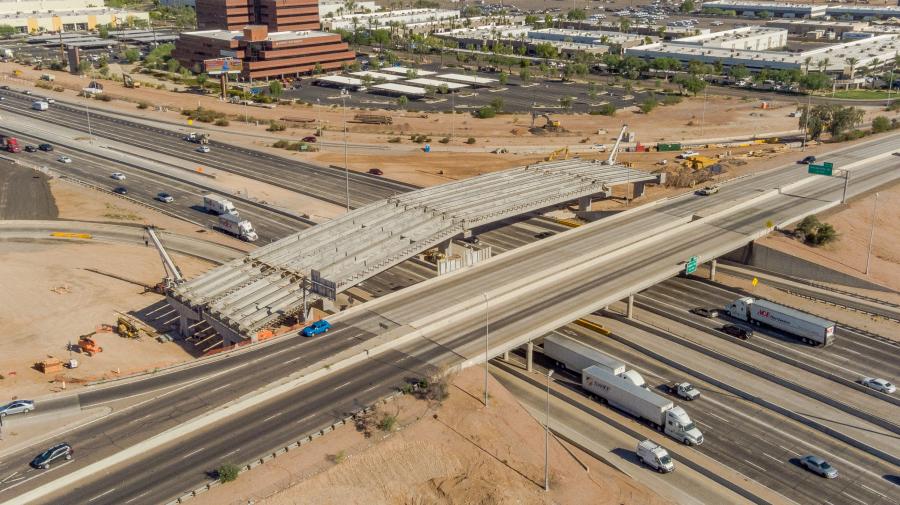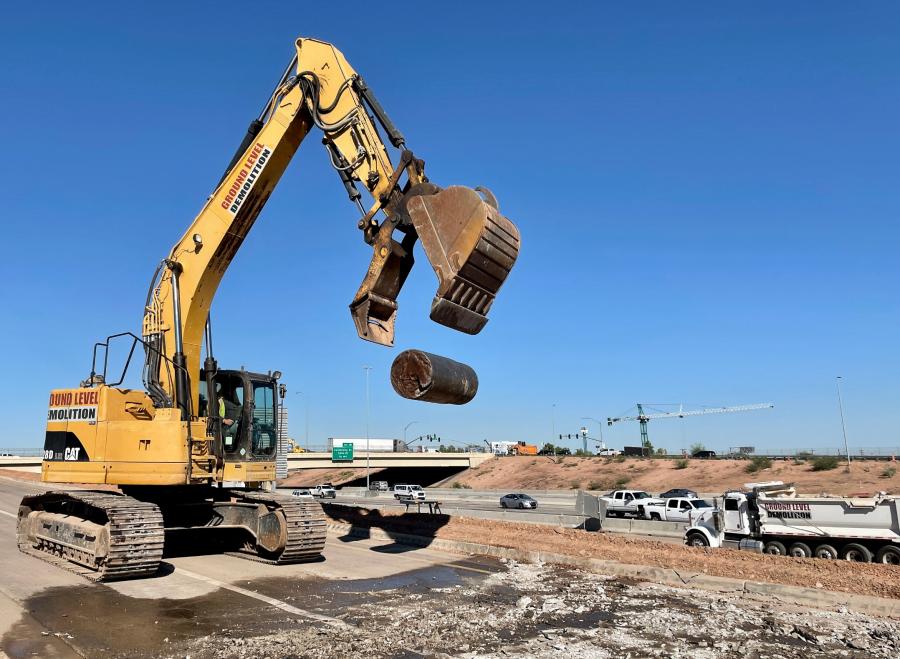Broadway Curve Constructors, a joint venture of Pulice Construction Inc., FNF Construction Inc. and Flatiron Constructors Inc., are performing significant upgrades on a stretch of I-10 in Phoenix, a project valued at $776 million.
(Photo courtesy of ADOT)
Phoenix, America's fifth-largest city, is being transformed by the Broadway Curve project.
The job will reduce traffic congestion and improve travel times during peak hours through the I-10 along the Broadway Curve, a stretch of I-10 between Baseline Road and 40th Street.
The project began in spring 2021 and is expected to be completed in late 2024.
The project developer, Broadway Curve Constructors — a joint venture of Pulice Construction Inc., FNF Construction Inc. and Flatiron Constructors Inc. — has removed the rubberized asphalt from 11 mi. of I-10 and 1 mi. of U.S. 60 in both directions, relocated utilities, installed new lighting and performed drainage work. The developer also has begun work on the new 48th Street and Broadway Road bridges over I-10.
During Phase 2, which began in July 2022, crews will focus on completing the construction of the new 48th Street and Broadway Road bridges over I-10; building collector-distributor roads; constructing the new bridges at the U.S. 60/I-10 interchange; relocating utilities; and building new barrier walls.
This project also includes widening the Guadalupe Road bridge over I-10 to improve the Sun Circle Trail, a 300-mi. loop trail used by pedestrians, cyclists and equestrians.
"This project is our largest urban freeway reconstruction project to date," said Marcy McMacken, spokesperson of the Arizona Department of Transportation (ADOT).
This project also will prepare the region for future growth projections, which indicate a 25 percent increase in traffic through the Broadway Curve area by 2040. Currently, more than 300,000 vehicles pass through the Broadway Curve area on an average weekday.
This complicated undertaking will cost $776 million.
ADOT has broken the project into three segments:
- West segment: East and westbound I-10 from 24th Street to the east of 40th street and will include the I-10 bridges over the Salt River;
- Central segment: East and westbound I-10 east of 40th Street and Broadway; and 1 mi. of Route 143 in both directions between I-10 and the Salt River;
- East segment: East and westbound I-10 between Broadway and Ray roads and including 1 mi. of U.S. 60 in both directions between I-10 and Hardy Drive.
Work will be happening on all segments simultaneously and will involve widening, paving, bridge construction and utility relocations. Phase one is finished with work under way on phase two.
Green Construction
Planners and workers have given special emphasis to environmental responsibility. Recycling used construction materials has been made a priority.
"We reuse as much as we can, so nothing goes to waste," Kole Dea, senior resident engineer of the Broadway Curve Project, said. "If something can't go back into the project, then it's recycled."
Some 1.3 million sq. yds. of millings are being used as the base layer for temporary haul roads in the project area. Millings provide a strong base for trucks and equipment to drive on and they help reduce dust.
Throughout the project, walls and other concrete structures are being taken down and reduced to pieces no larger than 24 in. Once broken down to the appropriate size, the concrete is used as fill to build up approaches for new bridges, fill up holes or help support unstable materials throughout the project area. The contractor sends unused metal and steel to a recycling factory.
Challenges
Like most multi-year construction projects, COVID has had an impact.
"The pandemic hit at a difficult time during the procurement phase of the project and at a time when public outreach needed to begin," said McMacken. "The project team was nearing the end of the procurement process and had to pivot and adjust to a virtual world."
COVID was not the only disruption.
"In May, the team needed to close I-10 in both directions and detour motorists to westbound U.S. 60," McMacken said. "However, a water main broke under U.S. 60, creating extensive flooding and damaging the U.S. 60 road surface. U.S. 60 was closed for repairs for several days. Without a viable detour available, crews again pivoted and rescheduled work, exhibiting the ability to modify their construction work plans."
ADOT is using new outreach tools, in addition to the traditional methods, to create awareness about this massive project.
"We launched ADOT's first project-specific, bilingual paid advertising campaign in the summer of 2021," said McMacken. "The campaign includes billboards as well as TV, radio, online, social media and paid search. Also, visitors who pass through Phoenix Sky Harbor International Airport will see project-related ads, so they are aware of the project construction taking place around the airport - which is in the heart of the busiest section of the project."
ADOT opted to utilize the public-private partnership (P3) statute to procure, design and build this project. A public-private partnership design-build makes it possible to deliver much needed transportation projects in a timely manner, often years before the projects could be delivered using traditional project-delivery methods.
"Opening the new eastbound travel lanes early in the life of this massive project provides tremendous value to thousands of motorists," said ADOT Director John Halikowski. "We are delighted we could make it happen and improve the afternoon and evening commute home for so many of our customers in Guadalupe, Tempe, Chandler and other areas of the Southeast Valley. We know this project is influential in other areas of I-10, the U.S. 60 and State Route 143. Opening up new travel lanes is one way we're striving to reduce the project's impacts for at least some motorists in the project area."
McMacken also sees a big impact to travelers in the Broadway Curve and throughout Phoenix.
"Once completed, motorists will notice reduced travel time during peak hours and improved access to and from Phoenix Sky Harbor International Airport," McMacken said. "They also will have improved access to the over 4,600 businesses within the project area, improved safety by reducing lane changes and ‘weaving' on Interstate 10 in the Broadway Curve area and on State Route 143 at University Drive. CEG
Chuck MacDonald
Chuck MacDonald is an editor, blogger and freelance feature writer whose writing adventures have taken him to 48 states and 10 countries. He has been the editor for magazines on pavement construction, chemicals, insurance and missions. Chuck enjoys bicycling, kayaking and reading. He graduated from the University of Missouri with a degree in journalism. Chuck lives in Annapolis, Md. with his wife Kristen. They have seven grandchildren.
Read more from Chuck MacDonald here.
Today's top stories


















